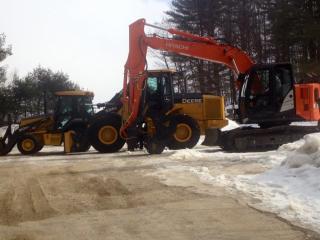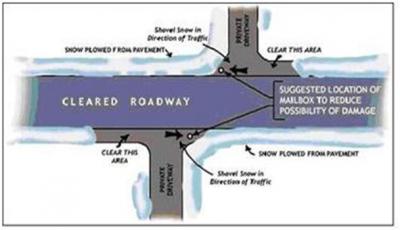Winter Operations

The Public Works Department is committed to providing the safest possible roads as cost efficiently as possible.
We communicate with Durham Fire & Rescue and will plow ahead of emergency vehicles to ensure a timely response. If you have an emergency and your road has accumulated snow, we will be there as soon as possible to clear the way.
The Department does its best to plow without any damage to mailboxes, but it happens sometimes. If your mailbox is damaged by Durham winter plow trucks, please read our mailbox policy.
Winter Equipment:
- Six (6) tandem axle dump trucks equipped with plows wings & material spreaders;
- Two (2) one ton dump trucks equipped with plows & material spreaders;
- One (1) ¾ ton pick up truck equipped with plow;
- Wheel loader;
- Loader backhoe;
- Back up tandem axle plow truck equipped with plow, wing & material spreader.
Before the Storm
Beginning in September the Department begins prepping for the upcoming winter. Tasks such as a comprehensive inspection of every piece of equipment from front to back, calibrating the spreaders, driving the plow routes for operator familiarity and hazard identification and procuring anti icing products and parts stock keep us very busy this time of year.
During the Storm
One of the most important steps in dealing with winter storms is “pretreating” the roads. Pretreating is what you see when the trucks are on the road just prior to or at the start of the storm and is referred to “anti icing”. These trucks are usually applying a light amount of salt and salt brine. Pretreating in this manner creates a salt brine barrier between the snow and the road keeping the snow from bonding to the surface and allowing us to achieve safe bare roads sooner, this process less costly than trying to melt off snow and ice pack after the storm. Once the snow has bonded to the road surface we have to enter into a costly “de-icing” operation.
The Department then begins its plowing routine, this generally begins as soon as accumulation starts and continues until the roads are clear and free of ice and snow. We concentrate our efforts on our main roads, which in Durham are roads such as Royalsborough Road, Newell Brook Road, Pinkham Brook Road, Hallowell Road, Swamp Road, Soper Road, Quaker Meetinghouse Road, Rabbit Road, Runaround Pond Road, Davis Road, Bowie Hill Road, Stackpole Road and Auburn Pownal Road. It is essential for the mobility of emergency vehicles as well as the public to keep the main roads as clear as possible. We continue plowing in this pattern for the duration of the storm making rounds on the secondary subdivision roads as needed.
Once the storm subsides we begin our “cleanup” operation. This usually consists of a final salt treatment to break up any remaining snow or ice, cleaning up intersections, and then scraping the slush of the road. The sooner we clear the road of moisture the sooner it can dry which helps to mitigate dangerous refreezing and costly “call backs”.
Each storm is different and presents challenges that can be difficult to handle. Things such as temperature, time of day, traffic conditions, rate of snowfall and type of snow are just some of the factors affecting the impact of a storm. The amount of snowfall alone can be deceptive. For example, a small storm during the weekday commute can cause major problems, while a similar storm on the weekend or late at night may cause little trouble. Light snow and heavy winds can cause additional drifting and ice buildup. Heavy wet snow will bring down trees and power lines creating a different set of problems as well as additional equipment strain and breakdowns. Snow turning to rain may cause low lying areas to flood requiring immediate attention to mitigate further problems, in this situation gravel roads usually turn to glare ice which becomes very slow to treat (sand) in a safe manner. Durham’s’ trained experienced crew works around the clock during these storms to keep roads open and passable for emergency vehicles as well as the general public. The crew is very dedicated and takes pride in plowing our roads in a safe professional manner.
After the Storm
In the days after a storm the crew spends time pushing back snow banks and intersections. It is important to push these banks back as far as reasonable to make room for the next storm and keep sight lines open at intersections. Once these banks have thawed a little and refreeze they are virtually impossible to move until they melt in the spring.
Once the roads are complete the crew begins the arduous task of cleaning all of the equipment used in the storm. Once cleaned they are brought through the shop and inspected with a fine tooth comb, serviced and repairs made in preparation for the next storm.
Information for Residents:
 Depositing snow in the roadway from your drive or walk is not only dangerous, it is illegal. If you have a contractor plow your drive, inform them not to push snow across the road. The "Cleared Roadway" diagram depicts the best way to perform your driveway snow removal to reduce the amount of snow that gets deposited into your driveway each time the plow goes by. By clearing the area just prior to your driveway, it allows the plow to “unload” before it reaches your driveway. Otherwise, mailboxes may be damaged during the winter. Many times the wing plow doesn’t hit the mailbox, but the snow coming off the wing does the damage.
Depositing snow in the roadway from your drive or walk is not only dangerous, it is illegal. If you have a contractor plow your drive, inform them not to push snow across the road. The "Cleared Roadway" diagram depicts the best way to perform your driveway snow removal to reduce the amount of snow that gets deposited into your driveway each time the plow goes by. By clearing the area just prior to your driveway, it allows the plow to “unload” before it reaches your driveway. Otherwise, mailboxes may be damaged during the winter. Many times the wing plow doesn’t hit the mailbox, but the snow coming off the wing does the damage.
If the storm is of long duration, the crew continues around the clock until the job is done, many times working all day, night, and well into the next day with little or no rest. That truck you saw on your way home in the evening, is the same truck and Plow Operator you see in the morning on your way back to work. The Plow Operators do not get a shift change. Remember, they have been out there all night working to keep the roads safe. We are not in competition with surrounding towns to achieve the best roads. Each town has its own policy. We strive for the safest roads at reasonable costs in the shortest amount of time.

